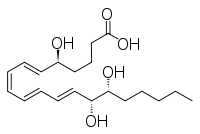Epimer
In stereochemistry, epimer refers to one of a pair of stereoisomers. The two isomers differ in configuration at only one stereogenic center. All other stereocenters in the molecules, if any, are the same in each.
Doxorubicin and epirubicin are two epimers that are used as drugs.
 |
Examples
The sugars glucose and galactose are epimers. In glucose, the -OH group on the first carbon is in the axial position, the direction opposite the -OH group on carbon C-4. In galactose, the -OH group is oriented in the same direction, the equatorial position.[1] In cyclical compounds like these, the -OH group on C-1 may lie in opposite directions as well. This structural difference distinguishes two anomers. The two molecules pictured are both epimers and anomers (as indicated by the α and β designation).
 |  |
|
|
The stereoisomers β-D-glucopyranose and β-D-mannopyranose are epimers because they differ only in the stereochemistry at the C-2 position. The hydroxyl group in β-D-glucopyranose is axial (up from the "plane" of the ring), while in β-D-mannopyranose the C-2 hydroxyl group is equatorial (in the "plane" of the ring). These two molecules are epimers but, because not mirror images of each other, are also not enantiomers (enantiomers have the same name but differ in D and L classification). They are also not sugar anomers, since the wrong carbon is involved in the stereochemistry.
 |  |
| |
|
Other closely related compounds are epi-inositol and inositol and lipoxin and epilipoxin.
 |  |  |  |
Epimerization
Epimerization is a chemical process where an epimer is made to transform into its chiral counterpart. It can happen in condensed tannins depolymerisation reactions. Epimerisation can be spontaneous (generally a slow process), or catalyzed by enzymes, e.g. the epimerization between the sugars N-acetylglucosamine and N-acetylmannosamine, which is catalyzed by Renin-Binding Protein.